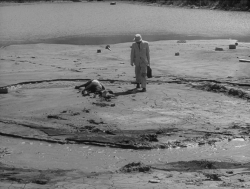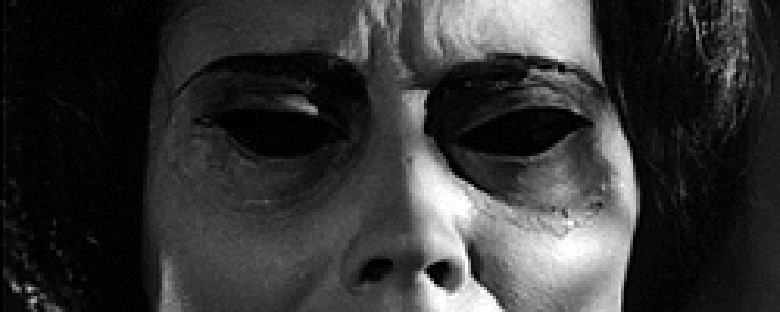Reviews
La Maldición de la Llorona
Rafael Baledón
Mexico, 1961
Credits
Review by Matt Bailey
Posted on 03 October 2006
Source CasaNegra DVD
Related articles
Features: 31 Days of Horror
Fans of Italian horror will have an overwhelming sense of déja vu during the first few moments of The Curse of the Crying Woman. “Where,” they may think to themselves, “have I seen this image before—this image of a woman in black, standing amidst swirling fog, holding her hounds on leashes?” It will not take long for them to figure out that they are beholding a close approximation of Barbara Steele’s first appearance in Mario Bava’s seminal (and obviously influential) 1960 film, Black Sunday (known in Italy as La Maschera del demonio). And though the first scene of Rafael Baledón’s film borrows heavily from Bava’s (as much as they both borrow from the original gothic horror films of Hollywood’s early sound era and from the reinterpretations of those films from Britain’s Hammer Film Productions in the 1950s), it also demonstrates a formidable sense of the fantastic and an imaginative, confident command of film technique.
The Curse of the Crying Woman is resolutely Gothic, full of the genre’s characteristic tropes: an inherited curse, pervasive madness, a decaying old castle, a blurring of the line between life and death, mirroring and doubling, a persecuted ingénue, and an overpowering sense of impending doom. The title character — a variation on a Mexican folk tale of a woman, grieving her dead children, whose appearance is a harbinger of death — summons her niece to initiate her into her destiny as the next in a long line of murderous witches, and to assist in the resurrection of the original Llorona. The plot is basic, but it is served well by the heavy and effective atmosphere of the film and by the briskness of its plotting. The film lasts a mere eighty minutes and, with the possible exception of a fight scene between two men that feels more at home in one of the popular lucha libre films of the time, not a moment is wasted. Though there is nothing original at all about it (in addition to its murderous title character, it has a crippled manservant and a madman in the attic), the film is so tightly constructed, the narrative moved along so propulsively, and the experience of watching it so consistently and thrillingly strange, that it rises above the also-rans to become a minor classic of its genre.
Gothic horror is an old, hardy genre with its roots in Eighteenth-century literature, but its popularity is cyclical. When Alejandro Amenabar’s beautifully-made The Others, M. Night Shyamalan’s The Sixth Sense, and the films of Kiyoshi Kurosawa showed up a several years ago, I hoped with fervor that we were on the cusp of a new wave of gothic horror, the likes of which we had not seen since the 1960s. Alas, that wave never materialized, and instead we got a seemingly ceaseless surge of identically grim and cynical torture movies and insipid remakes. Future film historians and pop psychologists will no doubt see this as something very important to understanding the way we are dealing with our current world events, but it’s not much fun for those of us going to the movies now. Disappointment in today’s “product” aside, it must have been a great thrill for audiences in the early 1960s to experience a film like The Curse of the Crying Woman, essentially a catalog of effective fright techniques and filmmaking tricks. Miniatures, trick shots, superimpositions, lighting effects, rubber bats, cheap but effective foam rubber makeup, trap doors, fog machines, shock zooms, eerie music, rear projection, constructive editing—all have their moments in the film and all are used successfully.
By the time The Curse of the Crying Woman hit screens in Mexico (it showed on American television, imported and dubbed by K. Gordon Murray, in 1965 and received a theatrical release a few years later), this genre — gothic horror — had become a worldwide sensation once more: the aforementioned Hammer productions were revolutionizing the genre with the addition of a little more blood and a little more sex than had previously been permitted; the Italians, who had previously banned horror films entirely, were now making lushly atmospheric and literary tales of ancient vampires; and the Mexicans, under the leadership of producer and actor Abel Salazar, were infusing the Euro-American tropes of the horror film with local style and indigenous folklore (such as La Llorona and Aztec mummies). As is their wont, enterprising American producers saw a way to make a quick buck by importing and dubbing (and often mercilessly cutting) these films to play for a new generation of sticky-handed Saturday matinee-goers. K. Gordon Murray, a Florida-based producer, imported dozens of Mexican horror movies to the United States, dubbed them haphazardly, and released them to drive-ins and crumbling movie palaces across the country. It has taken decades for English-speaking film fans to be able to see many of these films as they were originally intended to be seen. Thanks to boutique DVD labels like CasaNegra (who are releasing beautiful editions of several Abel Salazar-produced Mexican horror films including The Witch’s Mirror, The Vampire, and Brainiac), those fans can now see movies — like Curse of the Crying Woman — that are decades old yet are still total revelations.
We don’t do comments anymore, but you may contact us here or find us on Twitter or Facebook.



